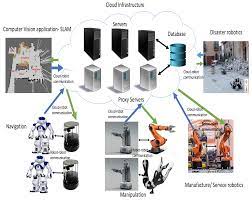The Role of Robotics in Disaster Response: Current Applications and Future Possibilities
Disaster response is a critical area where the use of robotics technology can make a significant difference. Robots can be used to assist in search and rescue operations, provide medical assistance, and perform other critical tasks in disaster-stricken areas. In this article, we explore the current applications and future possibilities of robotics in disaster response.
Current Applications of Robotics in Disaster Response
Search and Rescue: Robots can be used to search for survivors in disaster-stricken areas. They can navigate through debris and other obstacles and provide real-time data to rescue teams.
Medical Assistance: Robots can be used to provide medical assistance to injured individuals in disaster-stricken areas. They can perform tasks such as administering medication and monitoring vital signs.
Decontamination: Robots can be used to decontaminate disaster-stricken areas, reducing the risk of infection and disease.
Infrastructure Inspection: Robots can be used to inspect infrastructure such as buildings and bridges for damage, providing real-time data to aid in the recovery effort.
Communication: Robots can be used to provide communication assistance in disaster-stricken areas, such as by providing Wi-Fi access and facilitating communication between rescue teams.
Future Possibilities of Robotics in Disaster Response
Swarm Robotics: Swarm involves the use of multiple robots that work together to perform tasks in a coordinated manner. In disaster response, swarm can be used to search for survivors and provide medical assistance in a more efficient and coordinated manner.
Autonomous Drones: Autonomous drones can be used to provide real-time data on disaster-stricken areas, such as by mapping the area and identifying areas of need.
Humanoid Robots: Humanoid robots that are designed to resemble humans in appearance and behaviour can be used to provide more personalized assistance to individuals in disaster-stricken areas.
Exoskeletons: Exoskeletons, which are wearable devices that can enhance the physical abilities of humans, can be used to enhance the capabilities of rescue workers in disaster-stricken areas.
AI-Powered Virtual Assistants: AI-powered virtual assistants can be used to provide real-time assistance and support to rescue teams in disaster-stricken areas.

Challenges and Opportunities in Robotics in Disaster Response
Technical Complexity: Technology requires specialized technical expertise, which may be difficult for some disaster response teams to acquire.
Integration: Robotics technology requires integration with existing disaster response systems and processes, which can be challenging for some disaster response teams.
Ethical Concerns: Robotics technology raises ethical concerns, particularly around issues such as privacy and data security.
Liability: Robotics technology raises liability concerns, particularly around issues such as misdiagnosis and medical errors.
Adoption: Robotics technology requires investment in new technology and processes, which may be a barrier to adoption for some disaster response teams.
Preparing for the Future of Robotics in Disaster Response
To successfully leverage the potential technology in disaster response, disaster response teams should take the following steps:
Invest in Technical Expertise: Disaster response teams should invest in technical expertise and resources to successfully implement and manage systems.
Ensure Integration: Disaster response teams should ensure that systems are integrated with existing disaster response systems and processes to ensure that they can be used effectively.
Address Ethical Concerns: Disaster response teams should address ethical concerns by being transparent about how they are using technology and how they are protecting sensitive data.
Prioritize Liability: Disaster response teams should prioritize liability concerns and ensure that they have appropriate insurance and risk management strategies in place.
Collaborate: Disaster response teams should collaborate with industry partners and other stakeholders to share knowledge and resources, and to identify new opportunities for innovation and collaboration.

Conclusion
Robotics technology has the potential to transform disaster response by providing innovative and impactful solutions to complex problems. While it presents both challenges and opportunities, it is clear that robotics technology will play an increasingly important role in disaster response. By investing in technical expertise, ensuring integration, addressing ethical concerns, prioritizing liability, and collaborating with industry partners and other stakeholders, disaster response teams can successfully leverage robotics technology to provide innovative and impactful services to those affected by disaster. As robotics technology continues to evolve and become more sophisticated, we can expect to see new and innovative applications and use cases in disaster response, providing new opportunities for disaster response teams and society as a whole.
Moreover, the role of robotics in disaster response is not limited to the current applications and future possibilities discussed in this article. As robotics technology continues to evolve and become more sophisticated, we can expect to see new and innovative applications and use cases in various areas of disaster response.
For example, robotics technology can be used to provide more efficient and effective logistics and supply chain management in disaster response. It can also be used to provide more accurate and timely weather forecasting and prediction, allowing disaster response teams to better prepare and respond to disasters.
As new robotics applications and use cases are developed, it will be important for disaster response teams to continuously adapt and innovate to stay ahead of the curve.
One way to do this is to collaborate with industry partners, invest in research and development, and prioritize innovation and creativity. By doing so, disaster response teams can successfully leverage robotics technology to provide innovative and impactful services to those affected by disaster, while also adapting to the changing landscape of robotics technology.
Robotics technology has the potential to transform disaster response by providing innovative and impactful solutions to complex problems. While it presents both challenges and opportunities, it is clear that robotics technology will play an increasingly important role in disaster response. By investing in technical expertise, ensuring integration, addressing ethical concerns, prioritizing liability, and collaborating with industry partners and other stakeholders, disaster response teams can successfully leverage robotics technology to provide innovative and impactful services to those affected by disaster. As technology continues to evolve and become more sophisticated, we can expect to see new and innovative applications and use cases in disaster response, providing new opportunities for disaster response teams and society as a whole.
















